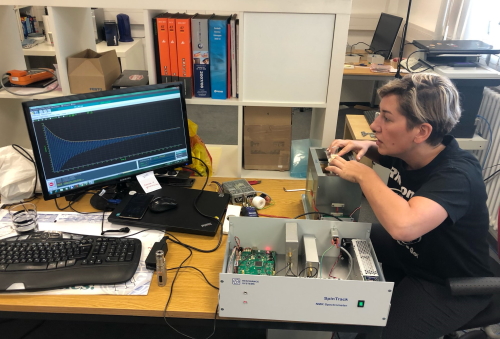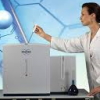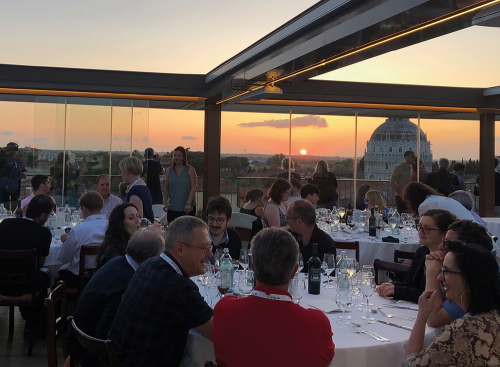September 3, 2019

NMR Hardware
and the
New Electronics:
a boat in
the Hurricane!
| Expanding NMR Relaxometry hardware offers
The array of relatively low-cost, FPGA-based time-domain and relaxometry NMR instruments available on the market is on the rise (click here for a hopefully complete list). It pleases me since it falls nicely in line with the talk I gave at the 2009 Valtice NMR meeting (click on the image on the left).
Most of the new instruments are table-top, all are based on a single digital control board, including frequency synthesis, pulser, RF receivers, etc, and all are PC-friendly. Only the prices are not yet as low as I hoped 10 years ago, though they are moving in the right direction.
The shot below shows Ester Maria Vasini (my Extra Byte colleague) focused on the search for the magnet's sweet spot of a Spin Track instrument at Resonance Systems. It illustrates nicely the idea of a modern low-field, LR-NMR hardware. The core of the instrument is the magnet (under Ester's hands), the probe (in her hands) and the digital chip at the center of the green printed board in the Spin Track console box. Plus the software to run and evaluate the experiments, of course.

As I said, interesting new instruments of this type start appearing ever more often. Another recent addition to the list that comes to my mind is the NMR relaxometer from Lab-Tools:

In my opinion, however, none of the TD-NMR instrument makers will strike gold just because they can build an instrument. That used to be sufficient up to, maybe, two decades ago, but today what matters most are very specific, worked-out applications. For example, it is not enough to say that "NMR can be used in food industry". One needs to detail what for (and how) it can be applied. Potentially, there could be hundreds of applications in the food industry (and in many other areas), but each of them needs to be studied in depth - and that can easily take months to do it properly. Just pointing out that something "could be done" is no longer sufficient.
We at Extra Byte will try and contribute to this process, mostly through software, helping (all) instrument makers develop applications suitable for their instruments. It is fun but it also takes a lot of work, so it looks like we might soon need help!
|
September 1, 2019
Hint:

JSON
with Base64
craftfully adapted
to scientific data
in a versatile way
???
| Urgently needed: data formats standardization
The following paragraph is a citation from a recent Biotechnology article by P-M Allard, J Bisson, A Azzollini, G F Pauli, G A Cordell and J-L Wolfender, entitled Pharmacognosy in the digital era: shifting to contextualized metabolomics.
"It is paramount that the data produced today will be available in the future. This requires open, properly-documented, quality-controlled formats, and, ideally, associated tools for analysis. Regrettably, contemporary analytical instruments typically produce data only in a vendor-specific, undocumented format. For MS data, functional alternatives exist, especially the mzXML format
[DOI 10.1038/nbt1031]. While no widely accepted format exists yet for NMR, candidates such as nmrML [DOI 10.1021/acs.analchem.7b02795], NMReDATA, and the Allotrope Foundation (AF) data standard have started to
appear. The AF initiative consists of a network of the major instrument manufacturers, industries, and academics. AF aims at developing a common format for analytical data, including LC, UV, IR, NMR, MS, and more. The collectively built ontologies, and the use of computationally efficient, standard hierarchical data format containers (HDF5), make this a most promising project, and worthy to follow."
I have taken the liberty to cite it because I could hardly express better my own concerns. Data formats (as well as acquisition-procedures definition formats) are becoming an acute problem across all STEM areas. There is a growing need to share raw data, make them more persistent in time and more accessible to an ever wider audience, even while the volumes of collected data are rising and new instrument manufacturers are springing up. The lack of agreed upon data formats, and the proliferation of often clumsy custom ones, is presently seriously hampering the development of Science and Technology. Magnetic Resonance in all its forms is certainly not foreign to this problem.
The pressure to standardize is rising from many sides. For example, ever more Countries are introducing laws obliging anybody involved in a publicly funded research to make available not only the results, but also all the raw data. Editors of major Journals are sensitive to the topic as well, due to not-so-rare litigations and even occasional cheats (faked results) that can not be resolved unless there is an access to the raw data. Referees would often like to see the raw data, too. And large Companies, such as Pharma's, need to maintain access to their own old data for many reasons, including patent litigations. Plus, new eveluation algorithms spring up all the time and it would be nice to be able to check on old results by applying them to the old data. After all, it is known that between 10% to 20% published scientific results are incorrect due to simple "misinterpretation in good faith".
Since Extra Byte is involved in the development of a software package for evaluation of time-domain and relaxometry data, we are directly affected by the incredible number of mutually incompatible number formats existing in the field. I have looked into the two above-cited standardization initiatives (NMReDATA and Allotrope Foundation). They are of course both laudable (better than nothing) but my impression is that they are slow and not fully aware of the full complexity of even just present data, not to speak about the arising needs that will certainly emerge during the next decade or so.
Sadly, I doubt that we will have any reasonable and agreed-upon data format any soon. Not in the next 10 years. I also see that most equipment manufacturers (OEM), focused as they are on the development of their hardware, are often insensitive to the data format problem, fixing or re-fixing their own private "standards" far too often, sometimes even starting from the scratch. We are here, ready to help, if need be and if we are up to it, but the OEM's tend to be proud and not very prone for collaboration. In most cases one ends up laboriously reverse-engineering the raw data and coding "data-translation" utilities (a loss of everybody's time).
I do not want to name anybody, but from what I have seen recently (as well as in the past), no NMR and/or MRI OEM's data format rises above the level of "much improvable" and some are really pitiful. And that is at individual level - just imagine standardizing between them.
I would be extremely glad to discuss this topic further with anybody interested!
|
August 26, 2019

Fourier 80
$90-120K

Clementino Fourier
$39.99
| Escalation of the Table-Top NMR Spectrometers War!
At the EUROISMAR Conference that is currently in progress in Berlin (Germany), one of the principal news is the presentation of Fourier 80, a new Bruker table-top NMR spectrometer operating at 80 MHz. It is the first Bruker instrument in this category, presented after a long period of rumors of the kind "Bruker is also working on it". From the outside, the look is not much dissimilar (by size and weight) from the other such instruments on the market. Its specifications, read out from the brochure distributed at EUROISMAR (see this scanned copy) are not bad; the resolution (0.5 Hz) is sufficient, though lower than comparable-field instruments of the 1980's, while the sensitivity is about 50% higher than then (200:1 for 1H-only system, 150:1 for 1H/13C on 1% EtB in a 5mm sample tube). The instrument comes in 1H and 1H/13C versions; other nuclei are possible, it seems, though subject to discussion. It is not clear whether, starting with 1H only, the instrument is upgradable to more nuclei. Overall, it is a good new entry to this highly competitive category, I would say.
In a subsequent entry I will try a general and maybe comparative reflection on the whole category of the table-top spectrometers. They now include, apart from the new Bruker product, the Spinsolve 60 and 80 MHz from Magritek, the NMReady 60 MHz and 100e/100PRO 100 MHz from Nanalysis (their NEW 100 MHz was presented yesterday at the ACS meeting in San Diego), and the Pulsar 60 MHz from Oxford Instruments.
|
July 12, 2019

| AIP - Applied Inverse Problems Conference in Grenoble
This was the first time I have attended this interesting and large international meeting, attended by about 500 participants. It consists of plenary lectures (exclusively invited) and many Minisymposia dedicated to various applied topics.
This year it was held in Grenoble (France) there was a Minisymposium on NMR Applications: Inverse Problems and Methods, organized by my friends Prof. Villiam Bortolotti and Prof. Fabiana Zama from University of Bologna. Like quite a few other people around the world (including myself and my collegues), they are interested in the Inverse Laplace Transform (ILT) methods that would be so helpful in NMR relaxometry, were it not for the fact that they tend to be ill-defined and unstable. They have invited me to deliver a talk on Realistic simulated MR data (virtual phantoms)
and the development of IP algorithms.
|
June 7, 2019

| Glimpses from the 11th FFC NMR Relaxometry Conference
The periodic Fast Field Cycling NMR Relaxometry meeting is dedicated mostly, but not exclusively, to NMR relaxation processes as a function of magnetic field strength and/or to nuclear magnetization evolution in variable magnetic fields.
The meeting is bi-annual. It started 22 years ago in Torino (Italy) and was initially held there, for several years. Later it became itinerant, though remaining prevalently European. It is a small, highly specialized meeting, typically counting around 100 participants.
This year it was held in Pisa (Italy) and the participants count was 90, coming from 22 Countries (!).
This is a shot of the spectacular sunset we have observed during the rooftop social dinner:

Comparing with some previous editions of this meeting that I have attended, my impression was that there is now less preoccupation with the often complex relaxation theories, and a growing accent on the expanding number of practical NMR relaxometry applications. A healthy tendency, I believe, even though the theory is important, too!
I have presented a lecture signed by me and my colleague Ester Maria Vasini about the expected (and corrigible) effects of FFC sequences on the relaxation times distributions in poly-dispersed (continuous and/or discrete) samples with differently relaxing components. The talk title was Field Cycling Relaxometry Of Polydispersed Samples: Some Special Aspects. It is a topic that we believe to be important when attempting to apply the FFC technique to complex and/or heterogeneous samples.
|
May 25, 2019
| For my Italian collegues: my Chapters in the book "RMN in Medicina"
Nel 1986, assieme a Cesare Ruffato, Gianni Bonera, Liliana Buttazzoni e Gino Paolucci ho scritto un libro intitolato Risonanza Magnetica Nucleare in Medicina e pubblicato da Piccin Nuova Libreria, Padova.
Ora, dopo oltre 30 anni, posso mettere nel dominio pubblico le Parti scritte da me stesso che sono disponibili al
DOI 10.3247/SL7NMR19.001 (Parte III, Principi fisici di formazione di immagine tramite RMN) e
DOI 10.3247/SL7NMR19.005 (Parte IV, Strumentazione RMN).
Ritengo che il libro possa avere ancora qualche valore didattico (I principi fisici non invecchiano), nonché storico (la strumentazione RM dei primi anni 80, i riferimenti alla letteratura fino al 1985). Per il resto, esso è ampiamente superato ed è opportuno che un eventuale lettore se ne renda conto.
A quanto mi risulti, il libro è ancora sul mercato, cosa che mi preoccupa non poco. Era il primo testo italiano sulla RM ed era stato usato per almeno 20 anni come libro di testo per chi sceglieva la specializzazione in fisica medica. Voglio sperare che oggi a tale scopo vengano utilizzati testi più aggiornati (ma non ne sono affatto sicuro).
Comunque sia, la due Parti sono ora "open access" :-)
|
March 3, 2019
| 2019 edition of the MMCE Conference
The MMCE stands for Magnetic Moments in Central Europe and it is an NMR meeting held every two years in one the Central and/or Eastern European countries. The 2019 edition was held in Prague (Czech Republic). The participants count oscillates quite a bit, generally around 100, and they come mostly - but not exclusively - from the Central European countris. Participants from Italy, Austria, Germany, Scandinavia, England and other places often show up. The Conference language is English, of course.
I like this Meeting for its explicitly educational mission statement (click the link and read the Mission Statement on the first page for details) and relatively low cost. The participant, especially the young ones, definitely benefit from participating and there is always a lot to learn for everybody, even those who had the illusion that they knew it all already (obviously, I am referring to myself 😄).
In this edition of the Meeting I was asked to prepare a Tutorial on Spin Systems in Magnetic Resonance. Since the time allocated for the presentation was too limited (45'), I could not cover the whole topic (not by a long shot), giving just a kind of extended introduction. This is something I would like to do better and in more detail, but the way I see it, it requires either a full Course or a book. In any case, if you are interested, use the link to see the slides. I will be returning to this topic again and again.
|
January 18, 2018

| Extra Byte reloaded
As of today, Extra Byte has been reloaded, rejuvenated, and is back to Life.

|
|
Archive
| For a complete list of all entries since 2005, see the running INDEX
|
|
Visitor #

ADVERTISE with us
NMR | MRI | ESR | NQR
Links
Companies
Societies
Centres & Groups
Journals & Blogs
References
Free Texts
History
BOOKS Lists
MATH | SOFTWARE
PHYSICS | CHEMISTRY
ELECTRONICS | DSP
Patents & IP | WWW
SPECTROSCOPY
INSTRUMENTATION
MRI | NMR | ESR
ARTICLES
Scalar relaxation
Biography of F.C.Yu
Hebel-Slichter effect
MR Antenna Theorem
NMR Dead Time
One-Page MR Primer
K-space and MRI
S/N Perspectives
OTHER
SI Units
Dimensions
Physics Constants
Math Constants
Science Links

Support this site!
SHOP from here:
COMPUTERS:
Deals
Bestsellers
Accessories
Calculators
This page is
SPONSORED by:

Random offers:
|